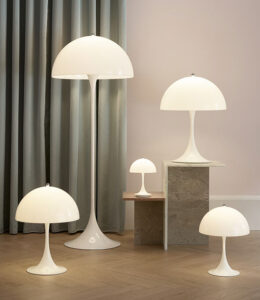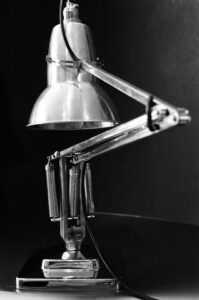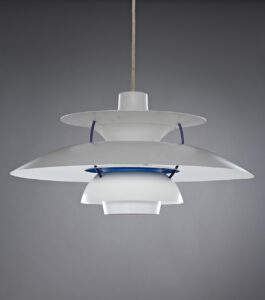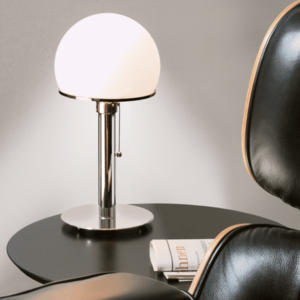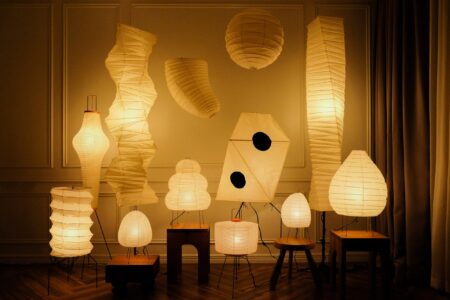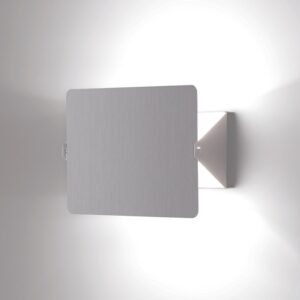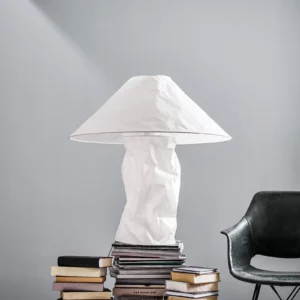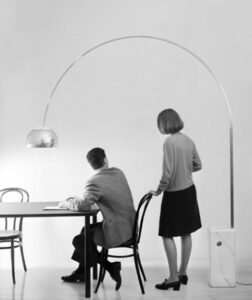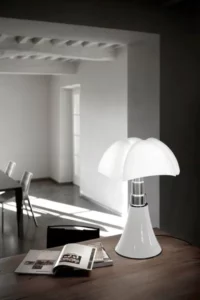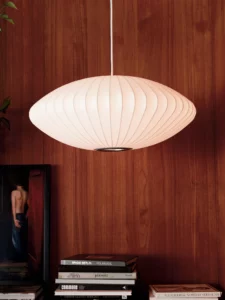Lighting is a rather distinctive area of design. These are mechanical objects that are first and foremost functional implements. They’re also mutable by nature and need to look beautiful both switched on and off. It’s a delicate line to walk as designers attempt to tick all the boxes of utility and aesthetics. The challenge was made all the more interesting by the technological landscape of the 20th century. From amidst those obstacles, came a cavalcade of ingenious lighting designs which feel just as fresh today as they did up to a century ago. We’ve gathered our top ten picks as a celebration of the most iconic lighting design of the 20th century. Join us for a walk through design history…
Panthella Lamp by Verner Panton
Verner Panton designed the Panthella lamp in 1971 using new-age materials like acrylic and chrome. It’s among the icons of the ‘70s, reflecting that curvaceous, often futuristic aesthetic of the era. The Panthella is essentially all curves, taking form as something of a hemisphere perched on top of a trumpet. That allows light the glide along its surface continuously, producing a harmonious ambient glow. The bulb is kept out of eyeshot; instead, the body of the lamp becomes the light source. The classic Panthella is white, enhancing its luminosity and imparting a particularly clean look. It remains one of Panton’s best-loved designs, with various iterations from floor lamps to portable battery-powered iterations cropping up in countless contemporary homes today.
Anglepoise Desk Lamp by George Carwardine
The Anglepoise desk lamp is undoubtedly among the most recognisable lighting designs on the market. The Original 1227 model was designed by the British automotive suspension engineer George Carwardine in 1935 with an eye to creating a task lamp that was highly adjustable and function-forward. He developed the constant tension spring technology in order to stabilise the light in whatever position the user needs it to be. The Anglepoise is the ideal tool for the job as British evenings creep up on winter afternoons while there’s still work to be done. Ultimately, Carwardine created a product which performs so well on a functional basis that it became a visual emblem for good design executed with simplicity and tact. To reflect the mechanical ingenuity of the lamp and embody something of a forward-facing aesthetic, the Anglepoise was then originally plated in chrome, giving it a glint of modernity.
PH 5 Pendant by Poul Henningsen
The PH 5 pendant lamp would have been a totally transfixing design when Poul Henningsen created it in 1958. It’s reflective of a mid-century technological acceleration which began to transform the way that people lived. Henningsen created the PH 5 in response to the practical problem of constantly evolving lightbulbs. He created a pendant light that works with any light source, futureproofing it as technology continued to progress ever more rapidly. The multi-shade format created a soft, glare-free glow to set the mood in modern dining rooms. The pendant was originally fitted with blue and red shades to optimise the colouring of the light it cast. Now the PH 5 comes in countless colour combinations, as bulb technology has improved to reproduce more pleasing, realistic light. Though, at the time, the way Henningsen harnessed design to work hand-in-hand with contemporary technology showed true ingenuity, producing a beautiful piece of iconic lighting in the process.
The Bauhaus Lamp by Wilhelm Wagenfeld
The Wagenfeld 24 table lamp is typically known as simply ‘the Bauhaus lamp’. It’s become something of a poster child for the lighting designs which came of out the Bauhaus’s Weimar workshop. In 1924 a 24-year-old Wilhelm Wagenfeld designed the lamp in response to a project assigned by teacher, László Moholy-Nagy. In line with the Bauhaus’s mission of democratising good design, the lamp was intended for a future of industrial manufacturing. Though, in fact, it was and continues to be made by hand. It takes shape in a combination of nickel and glass, giving it a polished, modern look. It’s still made to its original specifications today, using the same time-honoured materials which continue to carry a freshness even in contemporary environs.
Akari Light Sculptures by Isamu Noguchi
The Akari light sculptures of American-Japanese designer Isamu Noguchi have become true icons of modern design. Unlike many of the creations which came from the Modern movement, they don’t rely on new and innovative materials or mechanisms. Instead, Noguchi harked back to the traditional techniques and materials of Japan, leaning into an artisanal, handcrafted approach. He designed the first iteration in 1951 using pliant yet robust strands of bamboo to create the skeleton. Japanese washi paper is then painstakingly draped panel by panel until it creates an enclosed structure. What’s left is a beautifully sculptural shade of sorts which is entirely collapsible, adding an element of practicality. The intent was to create forms which are embodied ‘akari’, the Japanese term for light, brightness, and lightness. Noguchi ultimately created over 100 versions, which took on various shapes, sizes, and graphical patterns. They continue to be handcrafted in the same workshop where their story began, carrying on these Japanese traditions and techniques in a modern mode.
Applique à Volet Pivotant Wall Lamp by Charlotte Perriand
Charlotte Perriand was fascinated by people’s hand gestures. She, herself, is remembered as a particularly expressive character with a joie de vivre that’s echoed through much of her work. She designed the Applique à Volet Pivotant wall lamp in 1962, casting it in a cascade of uplifting colours alongside classically crisp brushed aluminium. The lamp itself is adjustable, tilting and twisting like a cocked hand so that it can give off an ambient glow, or direct light with a level of precision. This multi-functionality is reflective of Perriand’s conception of design as a function-forward means of supporting the daily rhythms of life.
Lampampe Lamp by Ingo Maurer
Munich-based designer Ingo Maurer created the Lampampe lamp in 1980, turning to humble paper as his material of choice. He fitted a specialised Japanese paper to a simple metal frame, creating a traditional lampshade which teeters on top of a deliberately crinkled paper base. Maurer often used paper in his designs and was inspired by its crispness and mutability. The bulb illuminates the translucent paper, exposing a slight graining which adds to the lamp’s character. The end result is luminous in its entirety and completely glare-free with a strikingly sculptural quality that continues to resonate today.
Arco Floor Lamp by Achille & Pier Giacomo Castiglioni
The Arco floor lamp was designed by brothers Achille and Pier Giacomo Castiglioni in 1962. It was the first of its kind, bringing light to hard-to-reach places in an unobtrusive way. It relies on a block white carrara marble, which provides a steady base with enough heft to counterbalance the pendant with clings to its long, arching arm. The arm is fashioned in stainless steel while the pendant itself is made from polished spun aluminium. The arm is telescopic, allowing users to adjust the position of the light as needed. It’s an emphatically dramatic design which continues to be celebrated (and in turn, emulated) for its sweeping scale and elegant simplicity.
Pipistrello Lamp by Gae Aulenti
The Pipistrello lamp is the creation of Italian designer Gae Aulenti. It went into production in 1965, at which point its futuristic form would have been fantastically novel to mid-century eyes. It’s quite an innovative design in form and material, with an adjustable telescopic stem of stainless steel which was originally lacquered in either white or chestnut brown. The shade is made in methacrylate, taking on a domed form which lends the lamp its name, the Italian word for ‘bat’. The slightly ballooning form of the shade’s quadrants are reminiscent of the wings of a bat catching and cradling the air. The result is a beloved design which beautifully balances the functional and the visually striking.
Saucer Lamp by George Nelson
The Saucer, also referred to as the Nelson Bubble lamp, was designed by the American George Nelson in 1947. Nelson took a shine to the stretched silk bubble pendants being designed in Sweden at the time. He wanted one for his architectural studio, but they were too expensive to justify. He then spotted a photo of sailing ships being sprayed down with a spiderweb-like resinous lacquer to seal the hulls. He’d found his solution, hunting down a supplier of the spray and getting to work. The interior is a metal cage that holds its shape under tension, minimising the need for tools and doing away with any welding entirely. This allowed the piece to be mass-produced at a palatable cost, making it a particularly affordable piece at the time of its invention. The cage is then coated in the military-grade spray before being cloaked in webbing plastic. The plastic is thin, maximising light and emitting a soothingly soft glow. It’s a beautiful example of classic mid-century modern design, made accessible to all.
The Story Continues
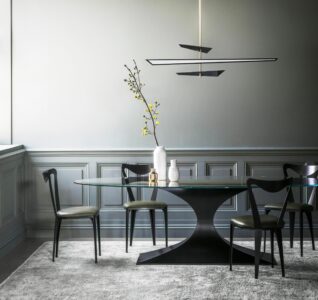
Our Phoenix chandelier finished in ‘Anthracite’ with a Capricorn oval dining table and Tiffany dining chairs
Tom has picked up the proverbial torch and adapted many of his creations into lighting. Like many 20th-century lighting designers, he also prizes simplicity, as well as strives to strike that elusive balance between form and function. The Phoenix chandelier is a fine example of his streamlined style. The Hug pendant reflects a meticulous approach to form, turning to continuous curves to cradle and direct light. Tom has also spun the Galena form into a table lamp, which stands strong as a functional sort of sculpture as its glow cascades down the geometrically striking body below. Because all our lighting, like our furniture, is made in metal, we find that finish goes a long way in setting the tone. A hand-painted Florentine Gold elevates the effect, giving off a crepuscular glow which shows off its surroundings in their very best light.
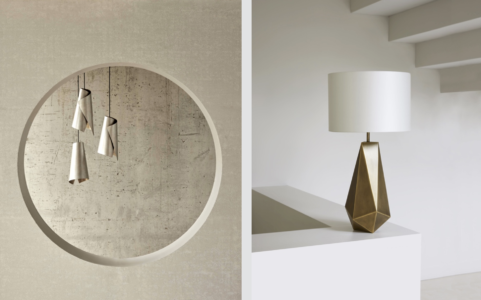
Our Hug pendants finished in ‘Persian Silver’ with ‘Florentine Gold’ interiors (left) + Galena lamp finished in ‘Florentine Gold’ (right)
Text by Annabel Colterjohn
